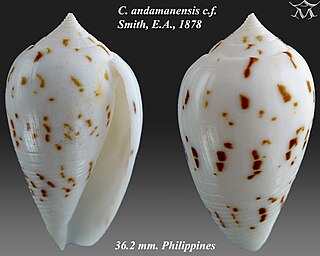
Eulophia andamanensis is an orchid found to occur among the Andaman and Nicobar group of Islands (off the east coast of India and also in the north-western tip of Langkawi island in Malaysia.The occurrence of this ground orchid in Andaman Islands is restricted to some isolated pockets of certain islands and rare. Living collections of this taxon from the Andaman Islands is under ex situ conservation outside the islands at the Field Gene Bank of Jawaharlal Nehru Tropical Botanic Garden and Research Institute, Trivandrum, India. It is a pre-tsunami accession.
Calotes andamanensis is an agamid lizard found on the Nicobar Islands and the Andaman Islands. It is also known as the green crestless forest lizard, Andaman and Nicobar forest lizard, Andaman lizard, or Andaman green calotes.
The Andaman worm snake is a species of harmless blind snake in the family Gerrhopilidae. The species is endemic to the Andaman Islands. No subspecies are currently recognized.

Boiga andamanensis, known commonly as the Andaman cat snake, is a species of rear-fanged mildly venomous snake in the family Colubridae. The species is endemic to the Andaman Islands.

The Andaman krait is a species of krait, a venomous elapid snake, which is found in the Andaman Islands of India.
The Andaman frog, chestnut-brown frog, or Andaman wart frog is a species of frog only found in the Andaman Islands, India. It has been regarded as a synonym of Limnonectes limnocharis, but is now considered a valid species. A related, unnamed species exists in western Thailand.
The Sikkim rat is a species of rodent in the family Muridae.

The Andaman drongo is a species of bird in the family Dicruridae. The species is endemic to the Andaman Islands of the Indian Ocean. There are two subspecies, the nominate race being found across the main islands of the archipelago, and the race dicruriformis occurring on Great Coco Island and Table Island in the north of the chain.

Phoenix andamanensis S. Barrow is a wild relative of date palm endemic to the Andaman Islands in the Bay of Bengal southwest of Myanmar. It is rather a newly described taxon by Sasha C. Barrow in 1998 based on old herbarium collections. This taxon was known only from a few herbarium collections and a few insignificant citations by Kurz in 1870, Brandis in 1906 and Parkinson in 1923. The Herbarium collections were made mostly during the British regime in 1903, 1904 and 1911 by Rogers and Osmaton. Later, Ellis from the Botanical Survey of India in 1990 collected one specimen from the Saddle Peak. The specimens were remained unidentified at herbaria until its circumscription as new taxon by Barrow in 1998.

The Andaman shrew or Andaman white-toothed shrew is a critically endangered species of mammal in the family Soricidae. It is endemic to the South Andaman Island of India. They are usually active by twilight or in the night and have specialized habitat requirements. Habitat loss due to selective logging, natural disasters such as tsunami and drastic weather change are thought to contribute to current population declines.

Conus andamanensis is a species of sea snail, a marine gastropod mollusk in the family Conidae, the cone snails and their allies.
Cuapetes andamanensis is a species of shrimp found in the Pacific and Indian Oceans. It was first named by Kemp in 1922.
Ranularia andamanensis is a species of predatory sea snail, a marine gastropod mollusk in the family Cymatiidae.

Sybra is a genus of beetles in the family Cerambycidae, containing the following species:

Sybra umbratica is a species of beetle in the family Cerambycidae. It was described by Pascoe in 1865.

Sybra ordinata is a species of beetle in the family Cerambycidae. It was described by Bates in 1873.

Chaetodon andamanensis, commonly known as the Andaman butterflyfish, is a fish native to the Indian Ocean.

Mimusops andamanensis is an endangered species of flowering plant enlisted in the World List of Threatened Trees with disjunct distribution in Sri Lanka and Andaman-Nicobar Islands. The ‘National Red List 2012 of Sri Lanka’ published by the Biodiversity Secretariat of the Sri Lankan Ministry of Environment in collaboration with the National Herbarium also included Mimusops andamanensis under endangered category as per the IUCN criteria B1(i, ii,iii) and 2ab. This species was originally described by King and Gamble in 1906 based on a specimen procured from Port Mount Hill jungle of South Andaman Island by one of the King’s collectors dated as 16/04/1892 and has no authentic information on this species until 2014 other than type collection. According to Balakrishnan and Rao (1983) this taxon was known only from its type collection. Mimusops andamanensis remained as an exclusive endemic of the Andaman Islands until the taxon has been recognized from Sri Lanka in 2001 indicating its disjunct distribution in far off insular habitats from Andaman Islands in the Bay of Bengal. Mathew et al. reported this species from the Little Andaman Island in 2014 after the type collection in 1892 and collected seeds. Seed germination protocol for Mimusops andamanensis under controlled conditions has also been standardized at Jawharlal Nehru Tropical Botanic Garden and Research Institute (JNTBGRI), Trivandrum, India as the part of ex-situ germplasm conservation of Andaman-Nicobar plant species outside the islands and the seedlings are well established qt the Field Gene Bank of the JNTBGRI(Mathew & Chitra, 2015).
Cesiribacter andamanensis is a Gram-negative, rod-shaped and non-motile bacterium from the genus of Cesiribacter which has been isolated from soil from a mud volcano on the Baratang Island in India.













